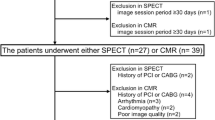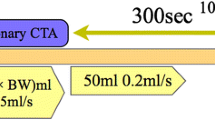Abstract
Objectives
To determine whether the quantification of iodine with stress dual-energy computed tomography (DECT-S) allows for the discrimination between a normal and an ischemic or necrotic myocardium using magnetic resonance (MR) as a reference.
Methods
This retrospective study was approved by the institutional review board, with waiver of informed consent. Thirty-six cardiac MR and DECT-S images from patients with suspected coronary artery disease were evaluated. Perfusion defects were visually determined, and myocardial iodine concentration was calculated by two observers using DECT colour-coded iodine maps. Iodine concentration differences were calculated using parametric tests. Receiver operating characteristic (ROC) curve analysis was conducted to estimate the optimal iodine concentration threshold for discriminating pathologic myocardium.
Results
In total, 576 cardiac segments were evaluated. There were differences in mean iodine concentration (p < 0.001) between normal (2.56 ± 0.66 mg/mL), ischemic (1.98 ± 0.36 mg/dL) and infarcted segments (1.35 ± 0.57 mg/mL). A myocardium iodine concentration of 2.1 mg/mL represented the optimal threshold to discriminate between normal and pathologic myocardium (sensitivity 75 %, specificity 73.6 %, area under the curve 0.806). Excellent agreement was found in measured myocardium iodine concentration (intraclass correlation coefficient 0.814).
Conclusion
Cardiac DECT-S with iodine quantification may be useful to differentiate healthy and ischemic or necrotic myocardium.
Key Points
• DECT-S allows for determination of myocardial iodine concentration as a quantitative perfusion parameter.
• A high interobserver correlation exists in measuring myocardial iodine concentration with DECT-S.
• Myocardial iodine concentration may be useful in the assessment of patients with CAD.






Similar content being viewed by others
Abbreviations
- CAD:
-
Coronary artery disease
- DECT-S:
-
Dual-energy CT stress
- MDCTA:
-
Multi-detector computed tomography angiography
- MRI:
-
Magnetic resonance imaging
- ROI:
-
Region of interest
- TGE:
-
Turbo gradient echo
References
Meijboom WB, Meijs MF, Schuijf JD et al (2008) Diagnostic accuracy of 64-slice computed tomography coronary angiography: a prospective, multicenter, multivendor study. J Am Coll Cardiol 52:2135–2144
Miller JM, Rochitte CE, Dewey M et al (2008) Diagnostic performance of coronary angiography by 64-row CT. N Engl J Med 359:2324–2336
Budoff MJ, Dowe D, Jollis JG et al (2008) Diagnostic performance of 64-multidetector row coronary computed tomographic angiography for evaluation of coronary artery stenosis in individuals without known coronary artery disease: results from the prospective multicenter ACCURACY (assessment by coronary computed tomographic angiography of individuals undergoing invasive coronary angiography) trial. J Am Coll Cardiol 52:1724–1732
Mark DB, Berman DS, Budoff MJ et al (2010) ACCF/ACR/AHA/NASCI/SAIP/SCAI/SCCT 2010 expert consensus document on coronary computed tomographic angiography: a report of the American College of Cardiology Foundation Task Force on Expert Consensus Documents. J Am Coll Cardiol 55:2663–2699
Meijboom WB, Van Mieghem CA, Van Pelt N et al (2008) Comprehensive assessment of coronary artery stenoses: computed tomography coronary angiography versus conventional coronary angiography and correlation with fractional flow reserve in patients with stable angina. J Am Coll Cardiol 52:636–643
Sato A, Hiroe M, Tamura M et al (2008) Quantitative measures of coronary stenosis severity by 64-slice CT angiography and relation to physiologic significance of perfusion in nonobese patients: comparison with stress myocardial perfusion imaging. J Nucl Med 49:564–572
Gaemperli O, Schepis T, Valenta I et al (2008) Functionally relevant coronary artery disease: comparison of 64-section CT angiography with myocardial perfusion SPECT. Radiology 248:414–423
Pflederer T, Marwan M, Renz A et al (2009) Noninvasive assessment of coronary in-stent restenosis by dual-source computed tomography. Am J Cardiol 103:812–817
Pugliese F, Weustink AC, Van Mieghem C et al (2008) Dual source coronary computed tomography angiography for detecting in-stent restenosis. Heart 94:848–854
Shaw LJ, Berman DS, Maron DJ et al (2008) Optimal medical therapy with or without percutaneous coronary intervention to reduce ischemic burden: results from the clinical outcomes utilizing revascularization and aggressive drug evaluation (COURAGE) trial nuclear substudy. Circulation 117:1283–1291
Boden WE, O’Rourke RA, Teo KK et al (2007) Optimal medical therapy with or without PCI for stable coronary disease. N Engl J Med 356:1503–1516
Hachamovitch R, Hayes SW, Friedman JD, Cohen I, Berman DS (2003) Comparison of the short-term survival benefit associated with revascularization compared with medical therapy in patients with no prior coronary artery disease undergoing stress myocardial perfusion single photon emission computed tomography. Circulation 107:2900–2907
Techasith T, Cury RC (2011) State myocardial CT perfusion. J Am Coll Cardiol 4:905–916
Feger S, Rief M, Zimmermann E et al (2015) Patient satisfaction with coronary CT angiography, myocardial CT perfusion, myocardial perfusion MRI, SPECT myocardial perfusion imaging and conventional coronary angiography. Eur Radiol 25:2115–2124
Bettencourt N, Rocha J, Ferreira N et al (2011) Incremental value of an integrated adenosine stress-rest MDCT perfusion protocol for detection of obstructive coronary artery disease. J Cardiovasc Comput Tomogr 5:392–405
Blankstein R, Shturman LD, Rogers IS et al (2009) Adenosine-induced stress myocardial perfusion imaging using dual-source cardiac computed tomography. J Am Coll Cardiol 54:1072–1084
Ko SM, Choi JW, Song MG et al (2011) Myocardial perfusion imaging using adenosine induced stress dual-energy computed tomography of the heart: comparison with cardiac magnetic resonance imaging and conventional coronary angiography. Eur Radiol 21:26–35
Ko SM, Song MG, Chee HK, Hwang HK, Feuchtner GM, Min JK (2014) Diagnostic performance of dual-energy CT stress myocardial perfusion imaging: direct comparison with cardiovascular MRI. AJR 203:605–613
Bamberg F, Becker A, Schwarz F et al (2011) Detection of hemodynamically significant coronary artery stenosis: incremental diagnostic value of dynamic CT-based myocardial perfusion imaging. Radiology 260:689–698
Bastarrika G, Ramos-Duran L, Rosenblum MA, Kang DK, Rowe GW, Schoepf UJ (2010) Adenosine-stress dynamic myocardial CT perfusion imaging: initial clinical experience. Investig Radiol 45:306–313
Mileto A, Marin D, Alfaro-Cordoba M et al (2014) Iodine quantification to distinguish clear cell from papillary renal cell carcinoma at dual-energy multidetector CT: a multireader diagnostic performance study. Radiology 273:813–820
Chandarana H, Megibow AJ, Cohen BA et al (2011) Iodine quantification with dual-energy CT: phantom study and preliminary experience with renal masses. AJR Am J Roentgenol 196:693–700
Meinel FG, Graef A, Thieme SF et al (2013) Assessing pulmonary perfusion in emphysema: automated quantification of perfused blood volume in dual-energy CTPA. Investig Radiol 48:79–85
Delgado C, Vázquez M, Oca R, Vilar M, Trinidad C, Sanmartin M (2013) Rev Esp Cardiol 66:864–870
Bossuyt PM, Reitsma JB, Bruns DE et al (2003) Towards complete and accurate reporting of studies of diagnostic accuracy: the STARD Initiative. Radiology 226:24–28
Ruzsics B, Schwarz F, Schoepf UJ et al (2009) Comparison of dual-energy computed tomography of the heart with single photon emission computed tomography for assessment of coronary artery stenosis and of the myocardial blood supply. Am J Cardiol 104:318–326
Deak PD, Smal Y, Kalender WA (2010) Multisection CT protocols: sex- and age-specific conversion factors used to determine effective dose from dose-length product. Radiology 257:158–166
Koonce JD, Vliegenthart R, Schoepf UJ et al (2014) Accuracy of dual-energy computed tomography for the measurement of iodine concentration using cardiac CT protocols: validation in a phantom model. Eur Radiol 24:512–518
Techasith T, Cury RC (2011) Stress myocardial CT perfusion: an update and future perspective. JACC Cardiovasc Imaging 4:905–916
Kitagawa K, George RT, Arbab-Zadeh A, Lima JAC, Lardo AC (2010) Characterization and correction of beam-hardening artifacts during dynamic volume CT assessment of myocardial perfusion. Radiology 256:111–118
Vliegenthart R, Pelgrim GJ, Ebersberger U, Rowe GW, Oudkerk M, Schoepf UJ (2012) Dual-energy CT of the heart. AJR 199:54–63
Marin D, Pratts-Emanuelli JJ, Mileto A et al (2015) Interdependencies of acquisition, detection, and reconstruction techniques on the accuracy of iodine quantification in varying patient sizes employing dual-energy CT. Eur Radiol 25:679–686
Acknowledgments
The scientific guarantor of this publication is Roque Oca Pernas. The authors of this manuscript declare no relationships with any companies whose products or services may be related to the subject matter of the article. The authors state that this work has not received any funding. One of the authors has significant statistical expertise. Institutional review board approval was obtained. Written informed consent was waived by the institutional review board. Some study subjects have been previously reported by Delgado, Vázquez, Oca, Vilar, Sanmartín (Myocardial ischemia evaluation with dual-source computed tomography: comparison with magnetic resonance imaging. Rev Esp Cardiol 66(11):864–870, 2013). Methodology: retrospective, diagnostic or prognostic study/observational, performed at one institution.
Author information
Authors and Affiliations
Corresponding author
Rights and permissions
About this article
Cite this article
Delgado Sánchez-Gracián, C., Oca Pernas, R., Trinidad López, C. et al. Quantitative myocardial perfusion with stress dual-energy CT: iodine concentration differences between normal and ischemic or necrotic myocardium. Initial experience. Eur Radiol 26, 3199–3207 (2016). https://doi.org/10.1007/s00330-015-4128-y
Received:
Revised:
Accepted:
Published:
Issue Date:
DOI: https://doi.org/10.1007/s00330-015-4128-y




